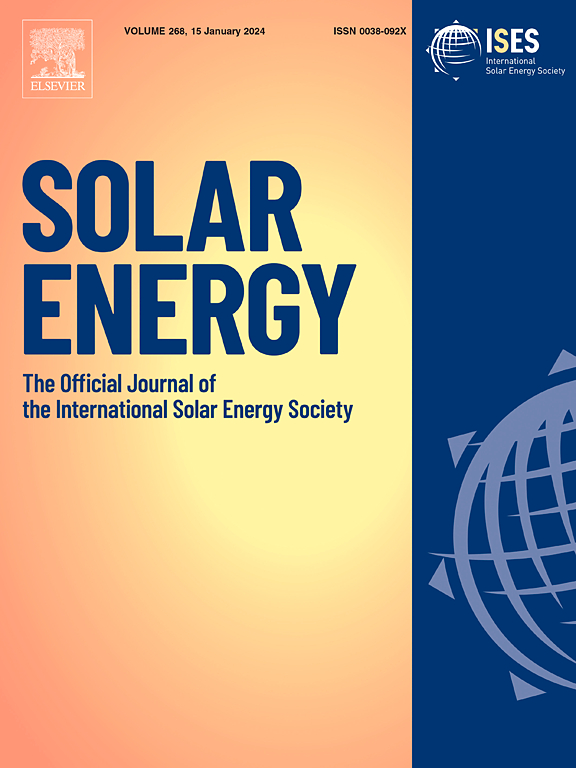Tailoring europium-doped CuBi2O4 nanorods for enhanced solar steam generation and desalination
IF 6
2区 工程技术
Q2 ENERGY & FUELS
引用次数: 0
Abstract
Freshwater scarcity is a growing global challenge, and solar-driven steam generation offers a promising, eco-friendly solution for desalination and water purification. However, its efficiency is often hindered by poor light absorption, high charge carrier recombination, and thermal losses. To address these limitations, we synthesized europium-doped copper bismuth oxide (Eu-CuBi2O4) nanorods using a hydrothermal method, enhancing photothermal conversion efficiency. By integrating these nanorods into a 2D evaporation structure where they were coated onto cotton gauze and insulated with polystyrene foam for better thermal confinement we achieved a highly efficient solar steam generator. Under 1 kW/m2 solar illumination, our system demonstrated an outstanding evaporation rate of 2.33 kg/m2⋅h, with an impressive solar-to-vapor conversion efficiency of 96 %, ensuring rapid and effective water evaporation. The system remained stable over 20 continuous cycles, maintaining efficiency without salt accumulation or performance loss. Thermal imaging confirmed that the material retained heat efficiently, reaching surface temperatures of 75.5 °C, further boosting evaporation rates. More importantly, this solar evaporator effectively removed over 95 % of dissolved salts (Na+, K+, Mg2+, Ca2+) and organic contaminants like Methylene Blue and Rhodamine B, even when processing high-salinity water up to 20 wt% brine. These results highlight Eu-CuBi2O4 nanorods as a powerful and sustainable photothermal material, paving the way for scalable, low-cost solar desalination and water purification technologies to meet the growing demand for clean water worldwide.
定制铕掺杂CuBi2O4纳米棒,用于增强太阳能蒸汽产生和海水淡化
淡水短缺是日益严重的全球挑战,太阳能驱动的蒸汽发电为海水淡化和水净化提供了一个有前途的、环保的解决方案。然而,它的效率往往受到光吸收差,高载流子复合和热损失的阻碍。为了解决这些限制,我们利用水热法合成了铕掺杂铜铋氧化物(Eu-CuBi2O4)纳米棒,提高了光热转换效率。通过将这些纳米棒整合到二维蒸发结构中,将它们涂在棉纱上,并用聚苯乙烯泡沫绝缘,以更好地进行热约束,我们实现了高效的太阳能蒸汽发生器。在1 kW/m2的光照条件下,系统的蒸发速率为2.33 kg/m2·h,太阳能-水蒸气转换效率高达96%,确保了水的快速有效蒸发。系统在20多个连续循环中保持稳定,在没有盐积累或性能损失的情况下保持效率。热成像证实,该材料有效地保留了热量,达到75.5°C的表面温度,进一步提高了蒸发速率。更重要的是,这种太阳能蒸煮器有效地去除95%以上的溶解盐(Na+, K+, Mg2+, Ca2+)和有机污染物,如亚甲基蓝和罗丹明B,即使在处理高盐度水高达20%的盐水时也是如此。这些结果突出了Eu-CuBi2O4纳米棒作为一种强大的、可持续的光热材料,为可扩展的、低成本的太阳能海水淡化和水净化技术铺平了道路,以满足全球对清洁水日益增长的需求。
本文章由计算机程序翻译,如有差异,请以英文原文为准。
求助全文
约1分钟内获得全文
求助全文
来源期刊

Solar Energy
工程技术-能源与燃料
CiteScore
13.90
自引率
9.00%
发文量
0
审稿时长
47 days
期刊介绍:
Solar Energy welcomes manuscripts presenting information not previously published in journals on any aspect of solar energy research, development, application, measurement or policy. The term "solar energy" in this context includes the indirect uses such as wind energy and biomass
 求助内容:
求助内容: 应助结果提醒方式:
应助结果提醒方式:


